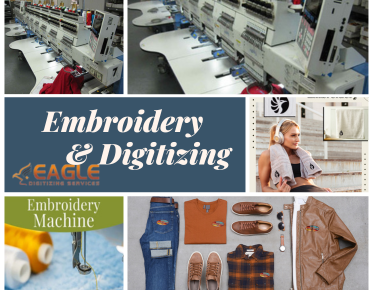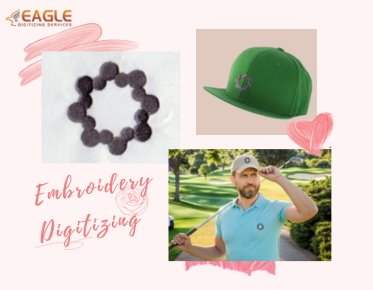Nail the Look: How to Select Placement for Embroidery on Shirts
Embroidery placement on shirts is more than just an aesthetic choice; it directly influences both the design’s impact and the garment’s wearability. A well-chosen placement can enhance the visual appeal, reinforce branding, and ensure that the design complements the shirt’s structure and function. Whether you’re outfitting a team, crafting promotional items, or personalizing casual wear, the right placement can make your embroidery stand out in the best way possible. Read Here are Some Things That You Should Know When It Comes To Embroidery Digitizing!
Common Embroidery Placement Areas
Embroidery placement can vary widely depending on the desired effect and the shirt's design. Common areas include the front chest, back, sleeves, collar, cuffs, hem, and waistband. Each location offers different opportunities for creativity and visibility, allowing for a range of styles from classic to contemporary.
Front Chest Placement
Centered Chest Design: Classic and Timeless
The centered chest placement is a quintessential choice in shirt embroidery. Positioned directly in the middle of the shirt’s front, this location is ideal for making a bold statement with logos or designs. It’s a classic choice that ensures the design is prominently displayed, making it a go-to for both corporate branding and casual personalization.
Left Chest Placement: Subtle Branding and Personalization
Left chest placement is favored for its subtlety and balance. Positioned over the heart, this spot is perfect for understated branding or personal touches. It’s often used for small logos, monograms, or simple designs that benefit from a discrete yet noticeable placement. This approach exudes professionalism while maintaining a low-key elegance.
Right Chest Placement: Unique and Modern Options
Right chest placement offers a unique twist to traditional shirt design. This location, often reserved for special occasions or modern fashion statements, provides an opportunity for a fresh and innovative look. Whether used for an asymmetric design or a second logo, right chest placement breaks the mold of conventional shirt decoration.
Back Placement
Full Back Embroidery: Making a Bold Statement
Full-back embroidery is the ultimate choice for those who want their design to make a grand entrance. Covering the entire back of the shirt, this placement is ideal for large, detailed designs or eye-catching graphics. It’s perfect for team shirts, promotional apparel, or any situation where the design needs to be the focal point.
Upper Back Placement: Balancing Visibility and Style
Upper back placement strikes a balance between visibility and subtlety. Positioned just below the neckline, it’s an excellent spot for medium-sized designs or logos that need to be visible without overwhelming the garment. This placement works well for both casual and professional shirts, offering a stylish yet restrained option.
Lower Back Placement: A Trendy and Casual Look
Lower back placement is a trend that’s gaining traction for its casual and relaxed vibe. Positioned near the waistband, this area is ideal for smaller, trend-focused designs or personal messages. It’s a popular choice for fashion-forward apparel where a unique touch is desired without taking center stage.
Sleeve Placement
Upper Sleeve Embroidery: Adding a Distinctive Touch
Upper sleeve embroidery adds a distinctive element to the shirt, perfect for logos, symbols, or small patterns. Positioned on the upper arm, this placement stands out and adds a layer of sophistication. It’s a popular choice for sports teams and fashion brands looking to add a touch of flair to their garments.
Lower Sleeve Designs: Subtle and Trendy Options
Lower sleeve embroidery offers a more subtle option for adding design elements. Positioned closer to the wrist, this area is ideal for small, trendy details that complement the overall shirt design. It’s a stylish choice for those looking to incorporate personal touches or minimalistic graphics.
Side Sleeve Placement: A Contemporary Approach
Side sleeve placement is a contemporary choice that adds a unique visual element to the shirt. Located along the side of the sleeve, this spot is ideal for designs that benefit from a modern and unconventional presentation. It’s perfect for fashion-forward designs or creative branding efforts.
Collar and Cuff Embroidery
Collar Embroidery: Elegant and Sophisticated
Embroidery on the collar adds an element of elegance and sophistication. Whether it’s a monogram or a small logo, this placement exudes refinement and attention to detail. It’s an excellent choice for high-end fashion or formal shirts where a touch of class is desired.
Cuff Designs: Small Details with Big Impact
Cuff embroidery is a subtle way to add personality and style to a shirt. Positioned on the cuffs, this placement allows for small, detailed designs that can enhance the overall look of the shirt. It’s perfect for adding a unique touch without overwhelming the garment.
Inside Collar and Cuff: Hidden Personalization
Embroidery on the inside of the collar or cuffs offers a hidden yet personal touch. This discreet placement is ideal for adding personal messages, names, or custom designs that are visible only to the wearer. It’s a great way to incorporate a touch of individuality or a special detail into the garment.
Hem and Waistband Embroidery
Bottom Hem Embroidery: Unconventional and Stylish
Bottom hem embroidery is an unconventional choice that adds a stylish twist to the shirt design. Positioned along the lower edge of the shirt, this placement is ideal for designs that need to be unique and eye-catching. It’s perfect for casual wear and fashion statements.
Waistband Designs: Adding Flair to Casual Wear
Embroidery on the waistband adds a touch of flair to casual shirts and sweatshirts. This placement is ideal for designs that complement the relaxed style of the garment, offering a distinctive look that enhances the overall aesthetic.
Side Hem Placement: Subtle and Unique
Side hem placement is a subtle and unique option for adding design elements. Positioned along the side of the hem, this area allows for small, creative designs that add an interesting detail without dominating the shirt. It’s ideal for personal touches or innovative branding.
Vertical vs. Horizontal Placement
Vertical Placement: Long Lines and Dynamic Designs
Vertical placement creates long lines and dynamic visual effects. This approach elongates the design, making it appear taller and more striking. It’s ideal for designs that benefit from a sense of movement or for creating a bold, linear statement.
Horizontal Placement: Balanced and Harmonious
Horizontal placement offers a balanced and harmonious look. This approach creates a sense of width and stability, making it ideal for designs that need to be centered or evenly distributed. It’s perfect for logos or patterns that benefit from a symmetrical presentation.
Design and Size Considerations
Matching Design Size to Placement Area
Matching the design size to the placement area is crucial for achieving a balanced and effective look. Ensure that the design is appropriately scaled for the chosen location to maintain visual harmony and ensure that it fits well within the space.
Adjusting Designs for Different Shirt Sizes
Designs may need to be adjusted for different shirt sizes to ensure consistency and visibility. Larger shirts may accommodate larger designs, while smaller shirts may require scaled-down versions. Proper adjustments help maintain the impact of the design across various sizes.
Ensuring Design Proportions and Visibility
Ensuring that design proportions and visibility are optimized is key to a successful embroidery placement. The design should be clear, well-aligned, and proportionate to the shirt’s dimensions. This ensures that the embroidery is both aesthetically pleasing and effectively communicated.
Branding and Marketing Considerations
How Placement Affects Brand Recognition
The placement of embroidery can significantly impact brand recognition. Strategic placement ensures that logos and designs are prominently displayed, enhancing visibility and reinforcing brand identity. Consistent placement across various garments helps build a recognizable and cohesive brand image.
Creating Consistent Brand Identity Through Placement
Consistent embroidery placement helps establish and maintain a unified brand identity. By using standard placement areas for logos and designs, brands can create a cohesive look that strengthens their visual presence and ensures recognition across different platforms.
Placement for Promotional and Corporate Shirts
For promotional and corporate shirts, placement is crucial for effective branding. Strategic positioning of logos and messages ensures maximum visibility and impact. Choosing the right placement helps convey professionalism and reinforces the intended message.
Technical Aspects of Placement
How Embroidery Placement Affects Shirt Comfort
Embroidery placement can affect shirt comfort, especially if the design is large or positioned in areas prone to friction. Considerations such as fabric type and placement location help ensure that the embroidery does not interfere with the shirt’s wearability.
Aligning Designs with Shirt Seams and Construction
Aligning designs with shirt seams and construction is important for achieving a polished look. Designs should be positioned to complement the shirt’s structure, avoiding seams and other features that may disrupt the embroidery.
Adjusting for Embroidery Hoop Limitations
Embroidery hoop limitations can impact placement options. Ensure that the design fits within the constraints of the embroidery machine and adjust placement accordingly to accommodate the available hoop size.
Custom vs. Standard Placement
When to Opt for Custom Placement Solutions
Custom placement solutions are ideal for unique or complex designs that require specific positioning. If standard options do not meet your needs, custom placements offer flexibility and precision for achieving the desired effect.
Benefits and Limitations of Standard Placement Options
Standard placement options offer ease of implementation and consistency. However, they may not always accommodate specialized designs or personal preferences. Understanding the benefits and limitations of standard options helps in making informed placement choices.
Practical Tips for Selecting Placement
How to Choose Placement Based on Shirt Style and Fabric
Choosing placement based on shirt style and fabric involves considering factors such as fabric texture, shirt cut, and overall design. Ensure that the placement complements the shirt’s style and works well with the chosen fabric to achieve the best results.
Tips for Visualizing Placement Options Before Embroidery
Visualizing placement options before embroidery can help ensure the design aligns with expectations. Use mock-ups or digital tools to preview how the design will look in different placement areas and make adjustments as needed.
Avoiding Common Mistakes in Placement Selection
Avoid common mistakes in placement selection by carefully considering factors such as size, alignment, and visibility. Ensure that the design complements the shirt’s structure and that placement does not interfere with seams or other features.
Achieving the perfect embroidery design requires thoughtful placement and attention to detail. By carefully selecting placement areas and considering technical and aesthetic factors, you can create an impactful and visually appealing embroidery design that stands out and enhances your shirt.



